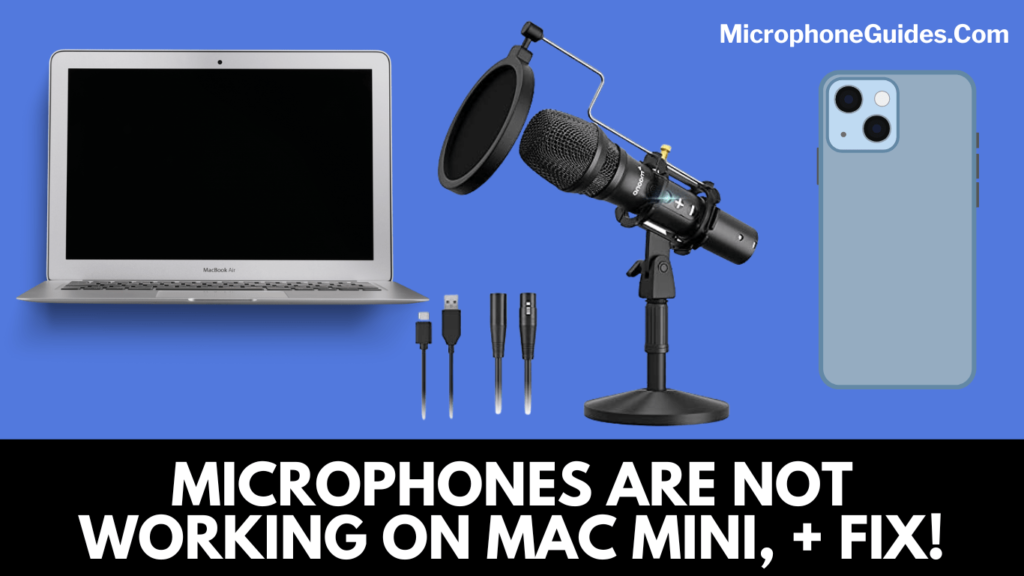Every single man on the planet knows how frustrating one gets when he plans to watch a movie to relax on a long weekend, and at the final moment, he realizes that his microphones are not aligning with his Mac!
Previously, it was considered an unfortunate incident that would take away your sleep and appetite from the time it appeared to the time it disappeared.
Nowadays, it is not a challenging thing. Easy Steps at home can fix the problem for you. Get into the article for getting information about the steps!

Let’s dive into the article for knowing more about things we need to do when microphones are not working on Mac!
Reasons for Microphone Not Aligning With Mac
Microphones not working on Mac is a common problem. The root cause of the problem ranges from transient software glitches to long-lasting non-recognition from the system itself.
You need to understand that it is not the rule of thumb that whatever microphones you bring must be recognized by the Mac you own. Systems function differently, which is why their response to any external device is entirely different from one another, even when both the devices come from the same manufacturer and share the same company’s logo.
In-built microphones usually show temporary issues that are far easy to fix than the issues shown by the external microphones.
Stay connected for making yourself accustomed to easy-to-take steps whenever you come across a similar situation!
What Should You Do If Microphones are Not Working on Mac?
- Shut Down Your Mac Only to Restart it
Do you come from the late 90s? If yes, you must remember how we would solve any issue that would, in a minor sense connected to a mobile or computer!
Okay, let’s break it down for the new generation. Whenever people from the late 90s faced an issue with their mobile or PC, they would simply switch it off only to restart it!
And guess what? In 99 percent of the cases, this would work positively for them.
You need to recreate this scenario once again. Whenever you feel like your microphone is not working. Just restart the Mac so that any trivial software glitch or stuck system would restore itself. It is the easiest thing you could do to fix the problem.
For that, go to the ‘Apple Logo’ printed at the top of the menu bar. There you would see the ‘Restart’ option. Jump into that and wait for a few seconds until the system restarts itself properly.
- Ensure that Mac Recognizes Your Microphone
The majority of Mac users don’t trust their in-built microphones that much. So whenever they have clients to meet on Zoom or Skype or have to deliver an important workshop to conduct online, they prefer good quality external microphones.
It is not a thing to stress about. First of all, open the ‘System Preference option present in the main menu bar. Click on that option. A list of options will pop up before you. From that list, select Sound. Once you opt for Sound, a list of options will become available to you. From that list, choose the one that says ‘Choose a Device for Sound Input’. Once you click on that option, go for ‘External Microphones,’ and your work will be done.
Wasn’t the process pretty much simple?
In rare cases, the microphones are still not recognized by Mac. If that happens to you as well, you need to buy TRRS Adapters. These adapters will make recognition easy for you.
TRRS cables are used widely for connecting Androids or iPhones to Macs or any other computer. These cables come with male and female plugs. Make sure you connect the plugs orderly; the female plug to your smartphone microphone and the male plug to your Mac.
Also Check: Fix Microphone Issue On Windows 10
- Keep the Input Volume Maximum
For about a week, I was facing microphone issues but couldn’t figure out the actual reason. I chuckled until my stoMach started to ache when I found out the problem was not with the microphone but with the volume.
This is a common thing we do. We try to find solutions to bigger problems while overlooking the smaller issues that are far easy to unravel. To curtail the same thing, make sure you check the Input Volume of the system before you try to contact professionals!
Maximizing volume is not a difficult thing to do. You need to follow some easy steps, and you are ready to go;
- Go to the top menu bar of your Mac. Different options will appear in the down menu bar. From the options, click on System Preferences which is present at the 2nd or 3rd position.
- After clicking System Preferences, a horizontal menu bar will pop up with fewer options. From that bar, click on the option that says Sound.
- Click on that. An option will appear ‘INPUT VOLUME’. CLICK on that and maximize the volume of your system. Once you are done with that, make sure you test the volume by speaking something random.
- The volume bars will show movement, which is a sign that volume is maximum and the microphone is all good to go with. If you couldn’t see any movement in volume bars, go to the troubleshooting option printed below on the same page.
Hopefully, your problem will be solved after troubleshooting.
Final Statement
So many Mac users have argued about the microphone issues during different situations and times, and they should because they have invested their hard-earned money in Mac. Though the problem is bothersome but not too difficult to deal with. Slight efforts would permanently fix the problem for you. Guiding steps are discussed above. Hopefully, they will help you. Stay connected for more knowledgeable content!

It’s me Brian Baldree professional sound engineer. I love to write about microphones, headphones, and musical instruments and review it’s quality.









